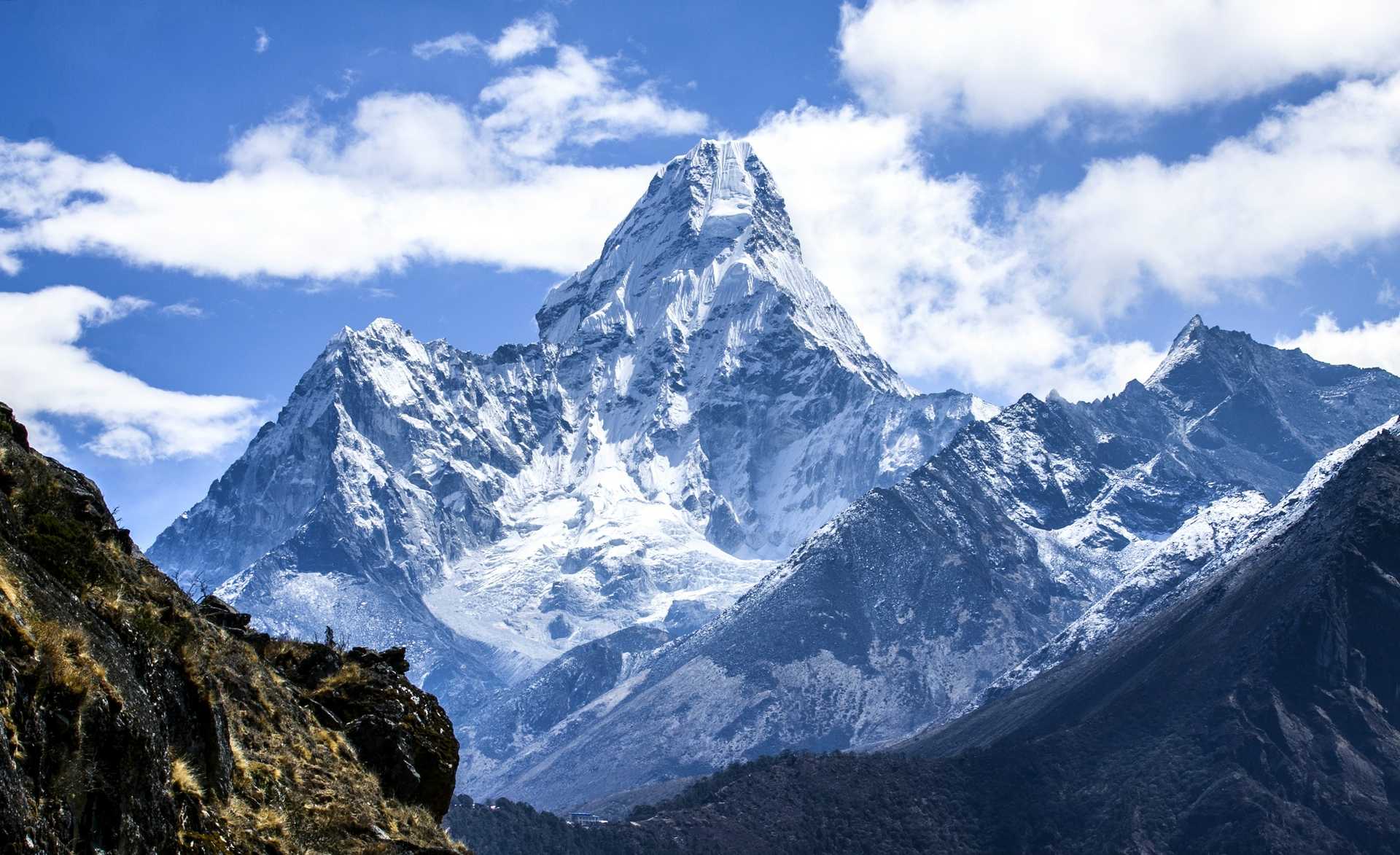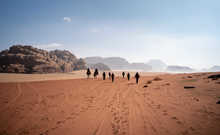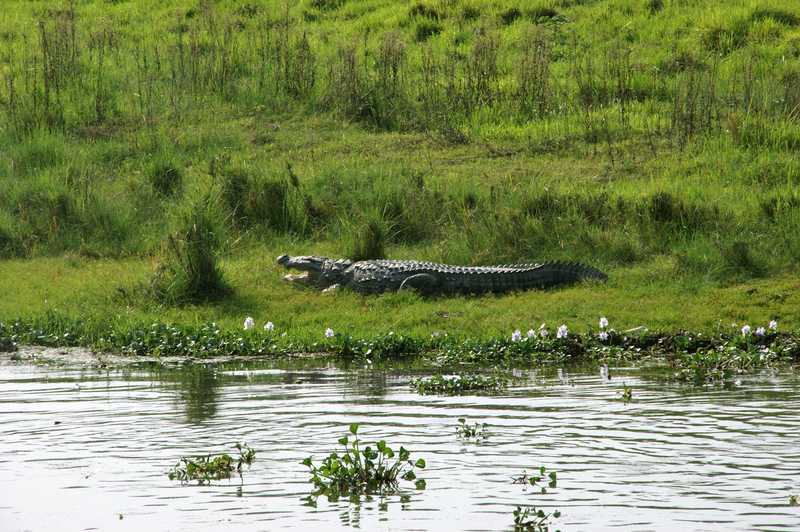Everest Base Camp
- Kandoo Trekking

Contact
our UK team

Arrive at Kathmandu International Airport where a member of the Kandoo team will be waiting to welcome you to Nepal. Private vehicle transfer to your hotel in the city. This afternoon you will meet your lead guide and the other members of your group for a pre-trek briefing in the hotel restaurant.
The flight from Kathmandu to Lukla takes 45 minutes and is an adventure in itself with great views of the Everest region (from the left of the plane) and ending with a hair-raising landing on a steep mountain runway. After meeting our crew, we will start our trek by heading up the Dudh Koshi Valley on a well- marked trail to Phakding
From Phakding, we cross and re-cross the river on high suspension bridges. Beyond Monjo is the entrance to the Sagarmatha National Park, which was set-up to conserve this fragile mountain environment. We then ascend steeply to Namche and along the way, if the weather permits, catch the first glimpse of Mt Everest. Namche Bazaar is the main trading village in Khumbu and has a busy Saturday market. It is a meeting place for the Hindu traders from the lowlands and Tibetan yak caravans that have crossed the glaciated Nangpa La. You can enjoy an Illy coffee and amazing brownies here!
Namche is tucked away between two ridges and has lots of lodges, tea shops and souvenir shops. Today we will trek up to the Everest View Hotel at 3880m for our first view of Ama Dablam and Mount Everest. Following the ‘walk high, sleep low’ principle, this hike will really help with your acclimatisation
From Namche, the trail contours on to the side of the valley, high above the Dudh Koshi. We will get great views of Everest, Lhotse, Nuptse and Ama Dablam. Passing by several villages and numerous tea shops, we descend steeply to a bridge over the river at Phunki Tenga. The village is an ideal stopover for lunch. Here we can rest before making the steep climb to Tengboche, famous for its legendary monastery, the largest in the Khumbu.
We descend through a forest, cross the Imja Khola and climb steadily to the village of Pangboche. This village is directly opposite Ama Dablam (6856m), and has exceptional views of the mountain, the gompa, Mani walls and scattered pine trees. A further two hours walk brings us to Pheriche.
A day for rest and acclimatisation. We also have an opportunity to wander up the valley to look at the Tshola Tsho lake and the perpendicular walls of Cholatse and Tawache. Our guide will take us up onto the ridge overlooking Dingboche for the view of the Imja Valley and the incredible south face of Lhotse.
We continue up the wide valley beneath the impressive peaks of Cholatse and Tawache on the left. We then turn right and take a steep climb towards the foot of the Khumbu Glacier. The tea house at Duglha is a good spot to have lunch. The trail zigzags up through the boulders of the glacier's terminal moraine. At the top of this climb there are many stone cairns, built as memorials to the many Sherpas who have died while climbing Mt Everest. The path then climbs gently along the glacier, to eventually reach Lobuche
To reach our next stop, Everest Base Camp, we follow the Khumbu Glacier. The trail offers superb views of the surrounding mountains, especially where the path is forced to rise to cross a tributary glacier. We stop for lunch at Gorak Shep before finally making our way to Base Camp itself (5364m). This takes several hours as the trail weaves its way through ice pinnacles and past the crevasses of the Khumbu Glacier.
A very early start is required to reach the top of Kala Pattar (5641m) for one of the best viewpoints in the Himalaya. From here we can see the face of Everest and deep into the Khumbu icefield. After lunch we then descend to Dingboche for the night.
From Dingboche we drop down again to follow the river. After crossing it we climb back up through birch and rhododendron forest back to Tengboche. From here we descend over the Dudh Koshi before making our way back to Namche.
Our final day's trekking follows the Dudh Koshi back down to Lukla. To celebrate our final night, we have dinner altogether this evening as a full team, it is customary for guests to buy dinner for the porters and guides on this night as a thank you for the support they have given you throughout the trek. There will also be an opportunity for you to hand out your tips for the support team during this meal.
After an early breakfast, we will begin our return journey to Kathmandu.
A free day in Kathmandu to explore the city at your leisure. The Buddhist stupa of Boudhanath, the Monkey Temple at Swayambhunath and the Hindu temple of Pashupatinath are just some of the religious highlights of this fascinating city.
We will collect you from your hotel and transfer you to Kathmandu Airport for your departing flight.
There are really just two things that make the trek tough. First, even with acclimatisation days you are pretty much trekking 5-6 hours a day for at least 12 days. You need to have hardened your body off to walking to cope with this.
Second, is the effect of altitude. By the time you reach base camp you will have lost almost 50% of the oxygen in the air and this makes any exertion tough. It is important, if you are going to cope with this loss of oxygen, that you train hard before you arrive for your trek, then do everything slowly. This is a 'tortoise challenge'!
One word of advice, place your meal order as soon as you can upon arriving at the lodge as it is strictly ‘first ordered, first served’, and the best lodges are quite busy at meal times.
Your
full day by day itinerary shows what is included in terms of hotel
accommodation and meal basis. All of our pre- and post-trek nights are in comfortable 4* hotel accommodation based in the Thamel District of Kathmandu.
We insist on using a high standard of
vehicle and driver for all of our transfers. In Nepal it is not a legal
requirement to have seatbelts fitted in the back of vehicles, and while we try
to use vehicles that do have rear seatbelts fitted, this cannot always be
guaranteed. If you are unhappy about any aspect of the vehicle or the standard
of driving, please speak to the driver or our local office.
Duffel bags
You will be provided with a large duffel bag at the pre-trek briefing that will be yours to use for the duration of your trek. Your equipment will then need to be transferred into this bag. If you are travelling with a duffel bag then it is up to you which bag you choose to use for the trek, if you are travelling with a suitcase then this will need to be left at the pre-trek hotel and collected upon your return as our porters need the bags they carry to be flexible.
All items must be packed in your main
equipment bag. They should not be attached to the outside, as we are not
responsible if items fall off when the bags are being carried on the trek.
We recommend that you take local currency on the actual trek
with you, as the teahouses prefer local currency. You will also get a more
favourable exchange rate in Kathmandu than in the mountains. If you are relying
on a credit or debit card for emergency funds, make sure you tell your card
issuer that you will be using it abroad, or you may find that it won't work
when you really need it.
In Kathmandu a meal for two at a mid range restaurant will
cost ~$20. A taxi will generally start on a base rate of $0.45 and then charge
$0.4 for every km. Or you can ride the bus which will be around $0.15 for a 5km
journey. Souvenirs in Kathmandu are generally on the cheaper side too.
Whilst on the trek, we recommend that you budget £30 - £35
($40 to $45) per day for meals and drinks.
We realise that tipping may not be a common practice in all
countries but for Nepal it is a standard practice that all operators
support. The decision on how much to tip should be determined by how well the
team served you while you were on the trek. Tips are always discretionary and
if you are not happy with the service you have received you do not have to pay
tips. Tips can be made in US dollars or Nepali Rupees. It is very important
that US bills be new (less than 10 years old), crisp and untorn.
We are members of the Trekking Agencies Association of Nepal
and the Nepal Mountaineering Association, and follow their guidelines when
recommending tip levels for guides and porters. We would suggest you budget
$200 per trekker for your tip contribution on this route. The group tip can be
given to your porters and guides during your celebratory meal in Lukla on the
final night of your trek. You will then say goodbye to your porters the
following morning.
Duffel bags
You will be provided with a large duffel bag at the pre-trek briefing that will be yours to use for the duration of your trek. Your equipment will then need to be transferred into this bag. If you are travelling with a duffel bag then it is up to you which bag you choose to use for the trek, if you are travelling with a suitcase then this will need to be left at the pre-trek hotel and collected upon your return as our porters need the bags they carry to be flexible.
We
do not have other gear available for rental but there are many places
offering gear for rental in Kathmandu and we can recommend a number of places
for you. The quality of rental gear is very variable and it is your
responsibility to check carefully the condition of any item you rent. We
accept no responsibility for the quality of equipment hired. An indication of
the likely rental costs is below.
Most
of the rental shops close around 8pm, so if you are arriving on a late flight
the day before the trek starts there will not be an opportunity for you to
visit a rental store. If you are planning on renting equipment, you need to
make sure you have allowed sufficient time at the beginning of your trip.
All
rental equipment is included in your overall trekking bag weight, so make
sure you have allowed for this when packing your bag at home. A sleeping bag
will weigh around 2kg.
UPPER
BODY
LEGS
FEET
OTHER ACCESSORIES
| From | To | Price | Availability | Book | Enquire |
|---|---|---|---|---|---|
| 24/01/2026 | 07/02/2026 | £1,549 $1,935 |
Guaranteed
|
Book now | Enquire now |
| 14/02/2026 | 28/02/2026 | £1,549 $1,935 |
Guaranteed
|
Book now | Enquire now |
| 07/03/2026 | 21/03/2026 | £1,549 $1,935 |
Guaranteed
|
Book now | Enquire now |
| 14/03/2026 | 28/03/2026 | £1,549 $1,935 |
Guaranteed
|
Book now | Enquire now |
| 21/03/2026 | 04/04/2026 | £1,599 $1,999 |
Guaranteed
|
Book now | Enquire now |
| 04/04/2026 | 18/04/2026 | £1,599 $1,999 |
Guaranteed
|
Book now | Enquire now |
| 11/04/2026 | 25/04/2026 | £1,599 $1,999 |
Guaranteed
|
Book now | Enquire now |
| 18/04/2026 | 02/05/2026 | £1,599 $1,999 |
Guaranteed
|
Book now | Enquire now |
| 25/04/2026 | 09/05/2026 | £1,599 $1,999 |
Guaranteed
|
Book now | Enquire now |
| 02/05/2026 | 16/05/2026 | £1,599 $1,999 |
Guaranteed
|
Book now | Enquire now |
| 09/05/2026 | 23/05/2026 | £1,599 $1,999 |
Guaranteed
|
Book now | Enquire now |
| 16/05/2026 | 30/05/2026 | £1,549 $1,935 |
Guaranteed
|
Book now | Enquire now |
| 05/09/2026 | 19/09/2026 | £1,549 $1,935 |
Guaranteed
|
Book now | Enquire now |
| 12/09/2026 | 26/09/2026 | £1,549 $1,935 |
Guaranteed
|
Book now | Enquire now |
| 19/09/2026 | 03/10/2026 | £1,549 $1,935 |
Guaranteed
|
Book now | Enquire now |
| 26/09/2026 | 10/10/2026 | £1,549 $1,935 |
Guaranteed
|
Book now | Enquire now |
| 03/10/2026 | 17/10/2026 | £1,599 $1,999 |
Guaranteed
|
Book now | Enquire now |
| 10/10/2026 | 24/10/2026 | £1,599 $1,999 |
Guaranteed
|
Book now | Enquire now |
| 17/10/2026 | 31/10/2026 | £1,599 $1,999 |
Guaranteed
|
Book now | Enquire now |
| 24/10/2026 | 07/11/2026 | £1,599 $1,999 |
Guaranteed
|
Book now | Enquire now |
| 31/10/2026 | 14/11/2026 | £1,599 $1,999 |
Guaranteed
|
Book now | Enquire now |
| 07/11/2026 | 21/11/2026 | £1,599 $1,999 |
Guaranteed
|
Book now | Enquire now |
| 14/11/2026 | 28/11/2026 | £1,549 $1,935 |
Guaranteed
|
Book now | Enquire now |
| 21/11/2026 | 05/12/2026 | £1,549 $1,935 |
Guaranteed
|
Book now | Enquire now |
| 28/11/2026 | 12/12/2026 | £1,549 $1,935 |
Guaranteed
|
Book now | Enquire now |
| 05/12/2026 | 19/12/2026 | £1,549 $1,935 |
Guaranteed
|
Book now | Enquire now |
| 09/01/2027 | 23/01/2027 | £1,699 $2,129 |
Guaranteed
|
Book now | Enquire now |
| 23/01/2027 | 06/02/2027 | £1,699 $2,129 |
Guaranteed
|
Book now | Enquire now |
| 30/01/2027 | 13/02/2027 | £1,699 $2,129 |
Guaranteed
|
Book now | Enquire now |
| 13/02/2027 | 27/02/2027 | £1,699 $2,129 |
Guaranteed
|
Book now | Enquire now |
| 27/02/2027 | 13/03/2027 | £1,699 $2,129 |
Guaranteed
|
Book now | Enquire now |
| 06/03/2027 | 20/03/2027 | £1,699 $2,129 |
Guaranteed
|
Book now | Enquire now |
| 13/03/2027 | 27/03/2027 | £1,699 $2,129 |
Guaranteed
|
Book now | Enquire now |
| 20/03/2027 | 03/04/2027 | £1,749 $2,199 |
Guaranteed
|
Book now | Enquire now |
| 27/03/2027 | 10/04/2027 | £1,749 $2,199 |
Guaranteed
|
Book now | Enquire now |
| 03/04/2027 | 17/04/2027 | £1,749 $2,199 |
Guaranteed
|
Book now | Enquire now |
| 10/04/2027 | 24/04/2027 | £1,749 $2,199 |
Guaranteed
|
Book now | Enquire now |
| 17/04/2027 | 01/05/2027 | £1,749 $2,199 |
Guaranteed
|
Book now | Enquire now |
| 24/04/2027 | 08/05/2027 | £1,749 $2,199 |
Guaranteed
|
Book now | Enquire now |
| 01/05/2027 | 15/05/2027 | £1,749 $2,199 |
Guaranteed
|
Book now | Enquire now |
| 08/05/2027 | 22/05/2027 | £1,749 $2,199 |
Guaranteed
|
Book now | Enquire now |
| 15/05/2027 | 29/05/2027 | £1,749 $2,199 |
Guaranteed
|
Book now | Enquire now |
| 04/09/2027 | 18/09/2027 | £1,699 $2,129 |
Guaranteed
|
Book now | Enquire now |
| 11/09/2027 | 25/09/2027 | £1,699 $2,129 |
Guaranteed
|
Book now | Enquire now |
| 18/09/2027 | 02/10/2027 | £1,699 $2,129 |
Guaranteed
|
Book now | Enquire now |
| 25/09/2027 | 09/10/2027 | £1,699 $2,129 |
Guaranteed
|
Book now | Enquire now |
| 02/10/2027 | 16/10/2027 | £1,749 $2,199 |
Guaranteed
|
Book now | Enquire now |
| 09/10/2027 | 23/10/2027 | £1,749 $2,199 |
Guaranteed
|
Book now | Enquire now |
| 16/10/2027 | 30/10/2027 | £1,749 $2,199 |
Guaranteed
|
Book now | Enquire now |
| 23/10/2027 | 06/11/2027 | £1,749 $2,199 |
Guaranteed
|
Book now | Enquire now |
| 30/10/2027 | 13/11/2027 | £1,749 $2,199 |
Guaranteed
|
Book now | Enquire now |
| 06/11/2027 | 20/11/2027 | £1,749 $2,199 |
Guaranteed
|
Book now | Enquire now |
| 13/11/2027 | 27/11/2027 | £1,749 $2,199 |
Guaranteed
|
Book now | Enquire now |
| 20/11/2027 | 04/12/2027 | £1,699 $2,129 |
Guaranteed
|
Book now | Enquire now |
| 27/11/2027 | 11/12/2027 | £1,699 $2,129 |
Guaranteed
|
Book now | Enquire now |
| 04/12/2027 | 18/12/2027 | £1,699 $2,129 |
Guaranteed
|
Book now | Enquire now |
| 07/04/2028 | 21/04/2028 | £1,799 $2,299 |
Available
|
Book now | Enquire now |
Want to ask us a question or book a private trip? Don't hesitate to contact us!
Contact us